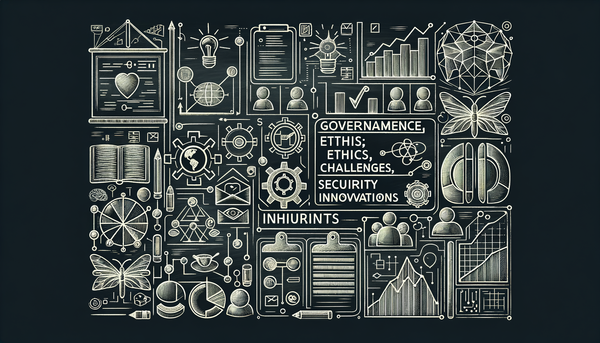AI Podcast Update: Innovations and Controversies

Did you know that a talking blob on your Samsung TV can spark debates about the intersection of entertainment, ethics, and business? From Microsoft's Copilot making an unexpected cameo on smart displays to reports of real-life tragedies linked to conversational AI, the landscape of artificial intelligence is evolving in surprising and sometimes unsettling ways.
Innovations in Smart Devices
Imagine sitting in your living room and engaging with a digital assistant that not only assists with everyday tasks, but also entertains you, almost like a quirky character straight out of a futuristic sitcom. Microsoft Copilot’s unexpected transformation into an interactive blob on Samsung TVs, as reported by Engadget, is a testament to how far AI has come in engaging users. This innovation isn’t just about a novel user interface—it signals a broader strategy to make technology more human-like and accessible.
Along with these advancements in software, the hardware sphere is also buzzing with revolutionary design. A series of reviews on the Google Pixel 10 and its siblings, including the Pixel 10 Pro and Pro XL (Engadget and CNET respectively), have sparked conversations among tech enthusiasts and everyday users alike. The advancements in triple-camera setups, processing power, and even AI-centric features have redefined what consumers expect from their smartphones.
Moreover, smart wearable technology is feeling the AI infusion. With the launch of new devices like the Pixel Watch 4, which integrates a Fitbit-inspired AI coach to encourage a healthier lifestyle, tech manufacturers are blurring the lines between gadgets and personal assistants. However, as noted by Android Central, while the promise of an AI coach is enticing, not every potential user is ready to embrace the digital health revolution. The conversation around usability and user engagement is vibrant, and experimenting with these devices might just be worth your while if you are curious to see how your habits can be optimized through data-driven coaching.
For an even deeper dive into these smart innovations, you may find our discussion on recent advancements in artificial intelligence insightful, as it probes further into the hardware-software synergy that is reshaping consumer tech.
Ethical Considerations and Controversies
While technological breakthroughs enliven our interactions with devices, they also raise serious ethical dilemmas. One especially somber story involves a teenager whose tragic death was linked, in part, to persistent interactions with ChatGPT, a tragedy detailed by The Guardian. This incident has ignited debates about the responsibility of AI developers in safeguarding mental health, especially among vulnerable populations.
Adding to these concerns, discussions on the potential risks of chatbots fueling delusional thinking have surfaced in various forums, including a compelling podcast segment by The Guardian. The dialogue around these issues underscores that while conversational AI systems can enhance productivity and engagement, they also require robust ethical frameworks and transparent usage guidelines to prevent unintended harm.
Experts in the field remind us of a timeless principle. In the words of Fei-Fei Li, "Weaponized AI is probably one of the most sensitized topics of AI - if not the most." The call for ethical oversight in AI development has never been more urgent. It is no longer enough to innovate without asking: how might our creations inadvertently affect society? Observers recommend that developers employ comprehensive safety checks and ensure that systems prompt users to seek professional advice when needed, especially in mental health contexts.
For more balanced perspectives on policy and legal controversies surrounding AI, you might want to check out our update on legal battles and job impact on AI.Biz.
Cybercrime and AI Misuse
Not all the stories of innovation are painted in bright hues. A report from Engadget shines a stark light on the darker side of AI—its exploitation in cybercrime. Anthropic's admission that its AI technology is being used to facilitate unlawful activities offers a cautionary tale illustrating the double-edged sword of technological progress.
This revelation not only compels us to re-examine the regulation of emerging technologies but also illustrates the urgent need to integrate advanced monitoring and security measures. Governments and tech companies alike find themselves in a race to strike the right balance between innovation and security. The situation reminds me of the adage from
Computers are not going to replace humans, but computers with artificial intelligence will enable humans to be better and faster at making decisions. – Andy Grove, Co-founder of Intel, 1997
This underscores the responsibility that accompanies such powerful tools.
In the realm of cybersecurity, the integration of AI into both defensive and offensive strategies is becoming increasingly common. As AI continues to evolve, so does its potential for misuse, urging a call to action for improved cybersecurity protocols that are as dynamic as the threats they aim to neutralize.
Business Impact of AI Advancements
The business landscape is reaping the rewards and facing the pressures of this unprecedented AI boom. Market giants such as Nvidia are experiencing record-breaking sales, despite concerns over an AI bubble and the impact of geopolitical issues. Reports from both the BBC and The Guardian capture a compelling narrative where a surge in demand for AI-related products drives financial performance to new heights.
These financial reports reveal that investors and tech enterprises are weighing both remarkable growth and caution. While strong sales figures underscore significant market demand, the simultaneous worries concerning geopolitical challenges and potential market bubbles inject a measure of skepticism into the overall picture.
In retrospect, the business story of AI is as much about careful strategy as it is about groundbreaking technologies. Business leaders must now navigate uncharted waters where strategic partnerships, regulatory considerations, and market analysis go hand in hand. Such dynamics are well reflected in our podcast update on recent developments in AI, which offers perspectives on emerging business trends and legal battles intertwined with AI innovations.
Indeed, the commercial side of the AI revolution is not just about rapid growth, but also about managing the intricate web of potential risks and regulatory challenges—a narrative that every stakeholder in the tech ecosystem needs to follow closely.
Emerging Trends and Reflections
The interconnected web of innovation, ethical dilemmas, and business dynamics paints a vibrant portrait of our AI-driven era. Looking forward, several key trends stand out as game-changers in the near future. Smart devices are evolving to become more interactive and engaging: they aren’t simply tools, but companions equipped with AI-driven personalities. The transformative improvement of user interfaces, as seen with the unexpected features of Samsung TVs and smartphones, suggests that the boundary between technology and everyday life continues to blur.
At the same time, the reflections on ethical challenges remind us that each technological leap demands corresponding advancements in safety and regulation. The contrasting stories—from innovative interfaces to tragic outcomes—invoke both wonder and caution. As one of our recent updates highlighted, the AI landscape is riddled with both promise and pitfalls. The interplay between human decision-making and machine assistance, as famously noted by Andy Grove, fosters an environment where informed decisions can be made faster and more efficiently.
Additionally, the threat of AI misuse in areas like cybercrime calls for a balanced approach where technological creativity is in step with robust legal frameworks and cybersecurity measures. The growing capability of AI systems to influence public and private sectors signals an impending transformation in how industries operate and how policies are formulated. Reflecting on William Gibson’s memorable observation that "The future is already here – it’s just not very evenly distributed," we are reminded that while some regions or sectors may leap ahead, others might struggle to catch up. This uneven diffusion of technology underscores the need for inclusive strategies in AI’s global deployment.
The evolution of AI is also an invitation for all of us to experiment with and embrace new technologies. Whether it is through adopting innovative smart devices or engaging with platforms that champion ethical AI usage, the time is ripe to be part of this ongoing conversation. If you’re intrigued by these rapid changes, consider delving into our intriguing updates on AI and society to gain further insights into how these trends resonate in everyday life.




